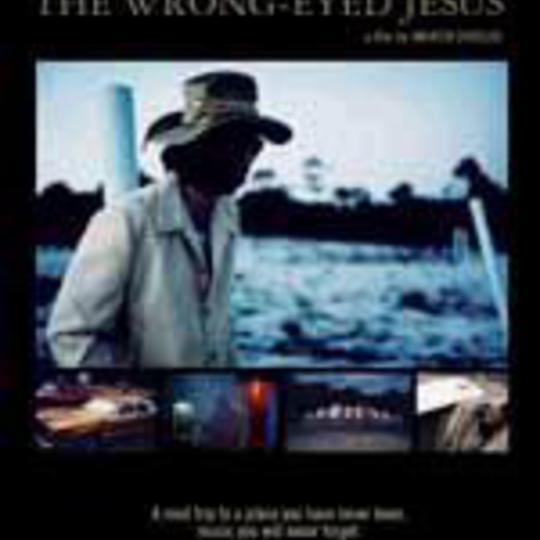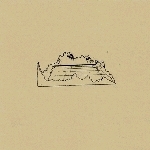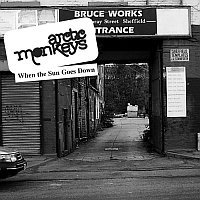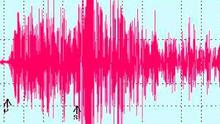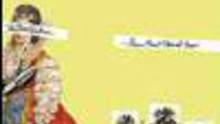“Without the Devil, what’s God? Nothing. The flames of Hell are all around you.”
The Handsome Family’s Rennie sits upfront in some low-riding American car I wouldn’t know the name of if it were written day-glow on its bumper, right beside something about the owner’s other vehicle being Jesus, or something about them travelling beside Him, or similar. She says the above words as Brett – glasses, beard, voice like a hundred Mark Lanegans – says nothing. Later they sing; they sing as the flames of Hell lick up against the heels of however many Southern gents and ladies Andrew Douglas’ award-winning documentary cares to focus its attention on over an hour and twenty-odd minutes.
Searching For The Wrong-Eyed Jesus follows acclaimed alt-country singer Jim White as he rides a borrowed and battered Chevy Impala through the South few care to wander; past the swamps and roadside bars, Pentecostal churches and small-town prisons that lie all of ten minutes or so from the raised interstate. Douglas’ work – his eye for an arresting image and superb editing – is consistent throughout, but it’s White that drives this film to its muted conclusion: set out for answers without first opening your heart, and the people of the old South will tell you nothing; “leave your mind behind and let your heart do the talking,” as White says about the Pentecostal church experience, “(and) things happen that defy explanation.” The film, co-financed by the BBC (click the link for further information and interviews) and therefore due for airing domestically prior to its January 30 DVD release, explores the avenues you’ve heard described on record but have never seen; here, they’re as inviting as they are alien and absurd.
“People here are full of spirit,” says White. “Every lamppost is a crucifix.” So it seems: God, Jesus, whatever – He’s here in each and every one of the people that Douglas’ camera spies, however intentionally set up such sequences may or may not be. A bar beside a freeway is dipped into in purposeful contrast to the previous scene’s Pentecostal proceedings: the clientele bump ‘n’ grind knowledgeable that they can repent, while murals of cartoon characters observe their boozing, Him many a thought away when the decorators showed. One of the film’s many (performing) alt-country/bluegrass performers, Johnny Dowd, sits at the bar, a smoke in one and a beer in the other. “All songs are about death, even when they’re about sex or food,” the silver-haired singer told Comes With A Smile magazine back in the summer of ’04 (issue 15); even the slightest toe into his troubled tales reveals as much. Dowd is not alone in hogging the spotlight for a few fleeting moments: elderly banjo player Lee Sexton does likewise, whiskey this and whiskey that, and the few glimpses of White himself alone at a microphone are utterly captivating.
David Eugene Edwards is here, too, lurking the woods no less: if Brett is a hundred Lanegans, then the former *Sixteen Horsepower *frontman sings with all the enflamed soul of a thousand slaves shackled in a line, axes digging into soil hardened by a sun unforgiving. Again, a little research reveals his own investment in God, or rather how clear-minded he is that his ability comes from above: “Oh definitely,” he answered when asked if his talent is God-given (again, this is in an old issue of Comes With A Smile magazine – issue 19, Autumn 2005); his grandfather was a preacher, he grew up on the gospel records of Cash and Williams. This remains the way of the South, of the old South, the South of fifty to a hundred years ago that still exists, a million light years from the influence of MTV. Giant pro-Lord (pro-Lord? Jeeeesus…) signs litter roadsides, painted large on corrugated roofs and billboards: Sheffield’s Where Jesus Is Lord states one. Somehow, one doubts such placards ever stood proud in a Yorkshire city centre.
Whatever the ways of the people that populate Douglas’ film – which has already won awards at the Seattle Film Festival and from the Royal Television Society – God’s presence is compellingly overpowering. Diners eat before a mural of angels rising from graves to God – “Hell to me is eternal,” says one customer, telling a story of a man seconds away from execution whose feet burned as the flames – those flames – came ever closer; ordinary folk shoot pool while a statue of Jesus looms over them. White himself carries an early-acquired statue in his trunk for all but ten minutes of the film – he pays sixty-five for it from a gentleman initially asking five-hundred: this is, one presumes, the Wrong-Eyed Jesus of the film* (it looks pretty odd), and one that is finally left to rest on a roadside as White drives off. Fade to black, cue credits.
(* The title also alludes to a Jim White record, The Mysterious Tale Of How I Shouted Wrong-Eyed Jesus!, available here for not a whole lotta money.)
Although the prevailing message is one of positivity – that these people are happy with their lots, and that their extremist ways (one Pentecostal preacher calls himself both an extremist and a radical) – White accurately picks up on an underlying disenchantment. These people, so happy to openly discuss the tragedies that have guided them to this course (two women talk of children lost in their teenage years), are nevertheless held here by a force so much stronger than that exerted upon those that grow up elsewhere. There is pressure to conform to what outsiders see as humorous stereotypes, ripe for parodying: “In a poor world like this, the gravity seems stronger,” observes White. At times, the sight of frantic adults holding children tight and screaming “Hallelujah” at them is most disconcerting.
That said, White obviously gains a lot from the experience, and leaves with certain demons exorcised, even if he never obviously (i.e. on camera) sets foot inside the well-documented Pentecostal healing services: footage from these is delivered speedily, so it disorientates as much as it informs. At the outset it’s obvious that this man – raised in Florida but always wary of the Southern folk that resided further west – had preconceptions to overcome. His talks frankly of his desire to leave home at an early age, at thirteen, but also of how what he left now seems that more beautiful; or rather of how what he thought wasn’t for him now is. He sees the wonder in a sunset over a swamp, in the dirt and grit of an upbringing so out of touch with modernity; he finds followers of the Outlaw lifestyle (look to Mick Farren’s great 1976 article ‘Live From Nashville’, reprinted in The Sound And The Fury (edited by Barney Hoskyns, 2003), for more information on the Outlaw cult) holed up in hellish multi-bunk prisons wishing they’d stayed on the straight ‘n’ narrow white line that White himself speaks of: of trying to follow a line on his bicycle but only sticking to it if he didn’t focus right on it. It could have been him. Down here it’s easy: there’s no middle ground between the saints and the sinners.
He drives through a park full of mobile homes: “These people have no wealth, but they enrich the world with their songs, stories and language. You could walk into any of these homes and hear the best, or saddest, story of your life.” We hear some of them: of talented banjo pickers having hands blown clean off in coal mines, of the rituals of possum and boar eating in the frozen winter months (you’d have to bury the discarded eyes of a possum downwards, so it didn’t climb out of the ground and come back for the one that killed it). We hear of birds spitting death into small children’s throats; most of the tales come from novelist Harry Crews, one of many individuals that require further investigation, such is his charisma on screen. His description of his accidental dunking in boiling water as a child, available on the extras, is worth the money for this alone.
As White drives away leaving his passenger in a lay-by, few of his questions have been accurately answered; there are many more doors opened than there are closed. White, though, leaves with the South in his blood; the viewer meanwhile switches their DVD player off feeling educated and compelled to sample some of that Southern hospitality themselves. Searching For The Wrong-Eyed Jesus is mystifying and wondrous, haunting and humbling: images will stay with you as long as the superb songs. Rusted cars on thunder roads, dusted whiskey bottles on a bar looking over beer-sodden revellers, God-fearing folk and good boys done wrong, twisted tree bark and barking hellhounds: there’s so much here to see that you’ve simply got to immerse yourself. You should see this film.
“Just where d’ya stop believing in this stuff? Where d’ya stop?”
Searching For The Wrong-Eyed Jesus is broadcast on BBC 2, on Monday January 23rd, at 11.20pm
-
8Mike Diver's Score

